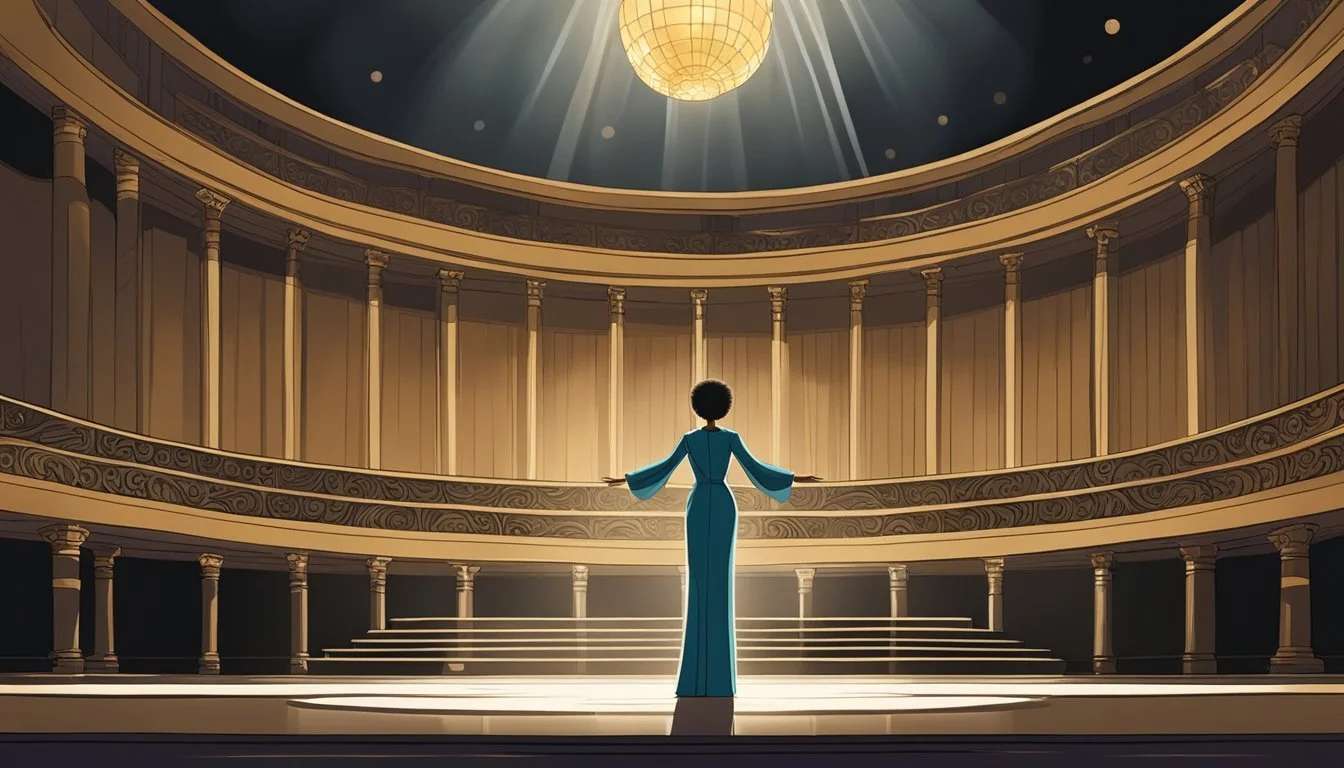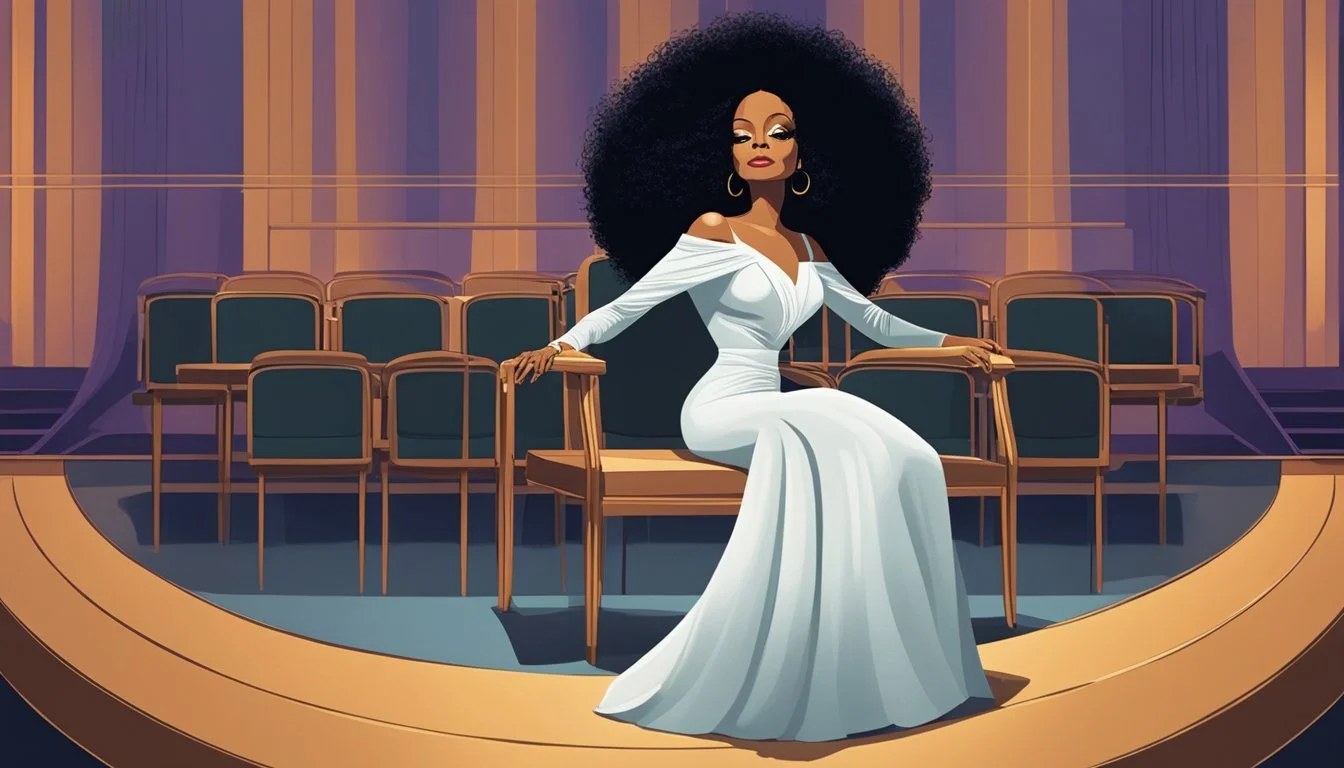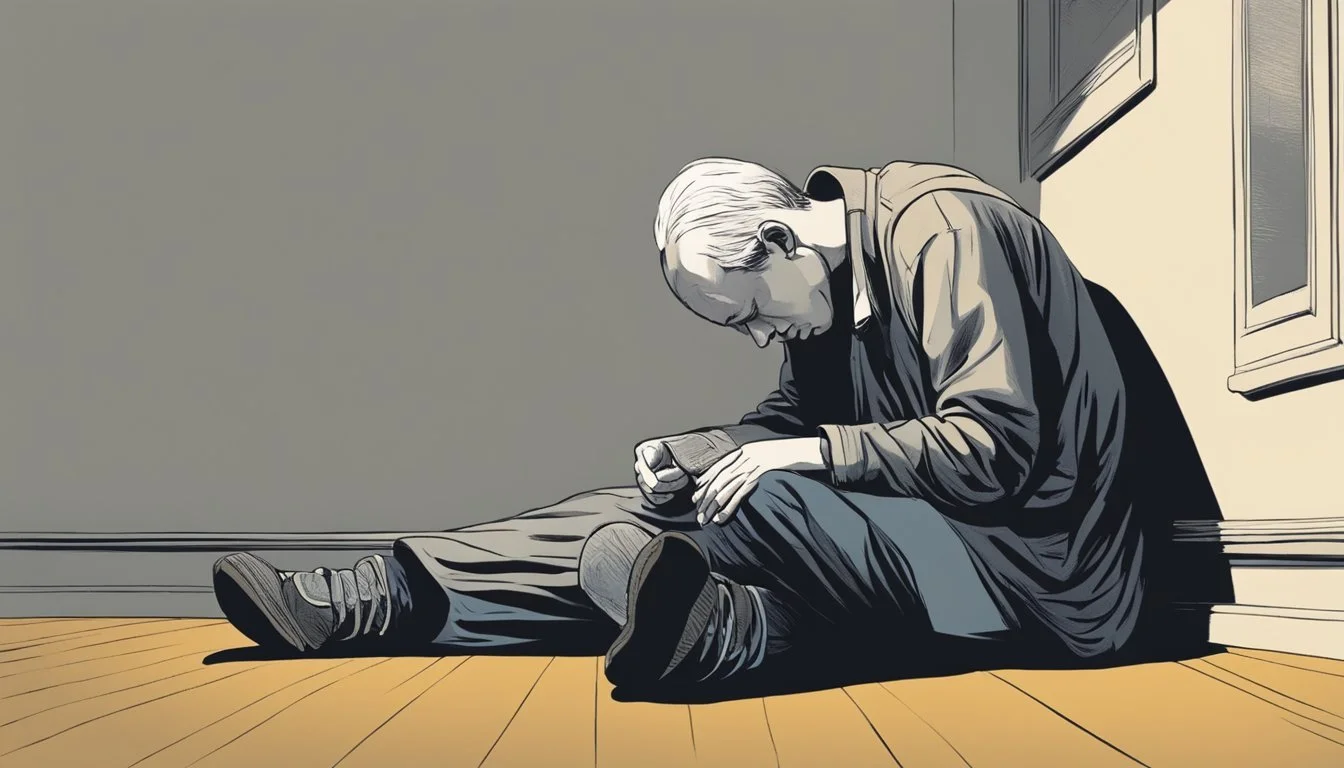Supreme Sorrow: Diana Ross' Battle with Depression
Motown Legend's Hidden Struggle
Diana Ross, the iconic lead singer of The Supremes, achieved tremendous success and fame during her career. Behind the glamorous image and chart-topping hits, Ross faced personal struggles that were hidden from public view. Despite her outward success, Diana Ross battled depression throughout her life, a condition that impacted both her personal relationships and professional endeavors.
The pressures of stardom and the demands of maintaining a high-profile career took their toll on Ross. As The Supremes rose to prominence in the 1960s, tensions grew within the group. Ross's departure from The Supremes in 1970 marked a significant turning point in her life and career. While she pursued a successful solo career, the transition brought new challenges and exacerbated her existing mental health issues.
Ross's battle with depression influenced her relationships with former bandmates and family members. The strain of maintaining her public persona while dealing with inner turmoil affected her interactions and decisions. Understanding Ross's struggle provides insight into the complexities of fame and the importance of mental health awareness in the entertainment industry.
Early Life and Formation of The Supremes
Diana Ross's journey to stardom began in Detroit, Michigan. Her early experiences and connections shaped the formation of The Supremes, one of the most successful girl groups in music history.
Detroit Roots and Primettes Era
Diana Ross was born on March 26, 1944, in Detroit. She grew up in the Brewster-Douglass housing projects, where she met Florence Ballard. In 1959, Ross, Ballard, Mary Wilson, and Betty McGlown formed a singing group called the Primettes.
The teenagers performed at local events and talent shows. They caught the attention of Motown founder Berry Gordy, who encouraged them to return after graduating high school. Barbara Martin briefly replaced McGlown before the group became a trio.
Rise of The Supremes and Motown Records
In 1961, the Primettes signed with Motown Records and changed their name to The Supremes. Initially, they struggled to find success, earning the nickname "no-hit Supremes" at the label.
Their breakthrough came in 1964 with "Where Did Our Love Go," which reached number one on the charts. This marked the beginning of an incredible run of hit songs. The lineup solidified with Ross, Wilson, and Ballard.
Motown groomed the group, focusing on their image and sound. Diana Ross emerged as the lead singer, causing tension within the group. In 1967, Cindy Birdsong replaced Ballard, marking a significant change in The Supremes' lineup.
Triumph and Tensions within The Supremes
The Supremes dominated 1960s pop music with their infectious hits and glamorous image. Their success was accompanied by internal conflicts and lineup changes that shaped the group's trajectory.
Chart-Topping Hits and Popularity
Diana Ross, Florence Ballard, and Mary Wilson formed The Supremes' classic lineup. They achieved unparalleled success with twelve #1 hits in the 1960s. "Where Did Our Love Go" launched them to stardom in 1964.
"Baby Love," "Come See About Me," and "Stop! In the Name of Love" followed, cementing their place atop the charts. The Holland-Dozier-Holland songwriting team crafted many of these hits.
The Supremes became Motown's flagship act. Their polished image and crossover appeal made them trailblazers for African-American artists in mainstream popular culture.
Internal Struggles and Line-Up Changes
Behind the scenes, tensions brewed. Diana Ross's increasing prominence caused friction within the group. Florence Ballard struggled with personal issues and was replaced by Cindy Birdsong in 1967.
The group was rebranded as "Diana Ross & The Supremes" in 1967. This move highlighted Ross's status but further strained relationships. Mary Wilson felt sidelined by the new dynamic.
Ross left for a solo career in 1970. The Supremes continued with new members but never recaptured their earlier heights. The original trio's bond had been irreparably altered by fame and internal conflicts.
Diana Ross' Solo Ascension
Diana Ross launched a successful solo career after leaving The Supremes, achieving both musical and cinematic success. Her talent and ambition propelled her to new heights as a solo artist in the 1970s and beyond.
Break From The Supremes and Solo Debut
Diana Ross parted ways with The Supremes in January 1970, embarking on her solo journey. Her debut single, "Reach Out and Touch (Somebody's Hand)," reached the top 20 on the Billboard Hot 100.
The follow-up, "Ain't No Mountain High Enough," became her first solo number-one hit. This Ashford & Simpson-penned track showcased Ross's powerful vocals and emotional range.
Ross continued to dominate the charts throughout the 1970s. She collaborated with various artists, including Marvin Gaye on the duet album "Diana & Marvin."
Her solo success solidified her status as a music icon. Ross's glamorous image and distinctive voice set her apart in the industry.
Cinematic Ventures and Critical Acclaim
In 1972, Diana Ross made her film debut in "Lady Sings the Blues." Her portrayal of jazz legend Billie Holiday earned her a Golden Globe and an Academy Award nomination.
The biographical film demonstrated Ross's versatility as an entertainer. Her performance received widespread critical acclaim, opening doors for future acting roles.
Ross continued her film career with "Mahogany" in 1975. She also starred in the film adaptation of the Broadway musical "The Wiz" in 1978.
Her music career reached new heights in 1981 with "Endless Love," a duet with Lionel Richie. The song topped the Billboard Hot 100 for nine weeks.
Ross's contributions to music were recognized with a Grammy Lifetime Achievement Award in 2012.
Collaborations and Continued Success
Diana Ross's career flourished beyond The Supremes, marked by remarkable partnerships and cultural impact. Her collaborations with fellow music icons and contributions to pop culture solidified her status as a music industry powerhouse.
Musical Partnerships and Hit Duets
Diana Ross joined forces with several Motown legends, creating memorable duets. Her collaboration with Marvin Gaye on the album "Diana & Marvin" produced hits like "You're a Special Part of Me" and "My Mistake (Was to Love You)." Ross and Lionel Richie's "Endless Love" topped charts worldwide in 1981, becoming one of the best-selling duets of all time.
She also worked with Michael Jackson on "Ease on Down the Road" for "The Wiz" soundtrack. Ross's partnership with Nile Rodgers in the 1980s resulted in the successful album "Diana," featuring the disco hit "Upside Down."
Contribution to Pop Culture and Music Evolution
Diana Ross's influence extended beyond music into fashion and film. Her glamorous style and stage presence inspired generations of performers. Ross starred in critically acclaimed films like "Lady Sings the Blues" and "Mahogany," showcasing her versatility as an entertainer.
In music, she seamlessly transitioned from soul to pop and disco, adapting to changing trends. Her solo hits like "Ain't No Mountain High Enough" and "I'm Coming Out" became anthems of empowerment. Ross's Grammy Lifetime Achievement Award in 2012 recognized her enduring impact on the music industry and pop culture.
Legacy and Influence in Music History
Diana Ross's impact on music and popular culture is immeasurable. Her groundbreaking career has left an indelible mark on the industry, inspiring generations of artists and breaking barriers for Black women in entertainment.
Awards and Achievements
Diana Ross has amassed an impressive array of accolades throughout her career. She was inducted into the Rock and Roll Hall of Fame as a member of The Supremes in 1988. Ross received a star on the Hollywood Walk of Fame in 1982, recognizing her contributions to the entertainment industry.
In 2012, the Recording Academy honored Ross with the Grammy Lifetime Achievement Award. This prestigious recognition celebrated her exceptional artistic significance to the field of recording.
Billboard Magazine named Ross the "Female Entertainer of the Century" in 1976, highlighting her unparalleled success on the pop charts. Her numerous number-one hits and record-breaking album sales solidified her status as a music icon.
Recognition Beyond Music
Ross's influence extends far beyond her musical achievements. She became a symbol of elegance, grace, and perseverance for Black women in the entertainment industry.
Her trailblazing career opened doors for future generations of artists. Many cite Ross as a major inspiration, from pop stars to R&B singers.
Ross's cultural impact is evident in her numerous film and television appearances. She starred in critically acclaimed movies like "Lady Sings the Blues" and "The Wiz," showcasing her versatility as an entertainer.
Her concert performances continue to captivate audiences worldwide. Ross's ability to command a stage and connect with fans has made her live shows legendary in the music industry.
Challenges and Personal Struggles
Diana Ross faced significant personal hardships throughout her career. Despite her public success, she battled internal demons and health issues that impacted her life and work.
Battling Depression and Personal Tribulations
Diana Ross struggled with depression for years, often masked by her glamorous public persona. The pressure of maintaining her image and career took a toll on her mental health. She experienced bouts of intense sadness and anxiety, particularly during her transition from The Supremes to a solo career.
Ross faced additional stress from her high-profile relationships and divorce. The demands of fame and constant media scrutiny exacerbated her emotional struggles. She sought therapy and worked to overcome these challenges privately while continuing to perform and record.
Health Issues and the Public Eye
In addition to mental health concerns, Diana Ross grappled with physical health problems. She battled anorexia, which affected her appearance and energy levels. The eating disorder became particularly evident during her performances in Las Vegas and on Broadway.
Ross's health issues occasionally impacted her ability to perform. A televised special in the 1980s showcased her struggle with exhaustion and vocal strain. Despite these setbacks, she persevered, often pushing through illnesses to fulfill her commitments.
The public scrutiny of her appearance and health added to Ross's stress. She faced criticism about her weight fluctuations and rumors about substance abuse. These challenges tested her resilience and forced her to confront personal issues while maintaining her career.
Discography and Significant Performances
Diana Ross's illustrious career spans decades, marked by chart-topping hits and unforgettable live performances. Her musical journey showcases both solo success and achievements with The Supremes.
Iconic Albums and Singles
Diana Ross's discography boasts 26 studio albums and 116 singles. With The Supremes, she released 12 studio albums, including the groundbreaking "Where Did Our Love Go" in 1964. This album featured the number-one hit "Baby Love," which solidified their place in music history.
As a solo artist, Ross continued to dominate charts. Her 1970 self-titled debut album included the Grammy-nominated "Ain't No Mountain High Enough," which reached number one on the Billboard Hot 100.
Ross's 1980 album "Diana" produced the dance classic "Upside Down." Throughout her career, she's earned 12 number-one singles on the Billboard Hot 100, cementing her status as a music icon.
Memorable Concerts and Tours
Diana Ross's live performances are legendary. Her 1983 Central Park concert in New York City drew an estimated 450,000 fans, despite being cut short due to severe weather.
The "Return to Love" tour in 2000 reunited Ross with former Supremes members, though it faced challenges. Her 2010-2011 "More Today Than Yesterday: The Greatest Hits Tour" celebrated her extensive catalog across North America.
In 2019, Ross performed at the Grammy Awards, showcasing her enduring talent. Her concerts often feature elaborate costume changes and a mix of Supremes classics and solo hits, delighting audiences worldwide.







